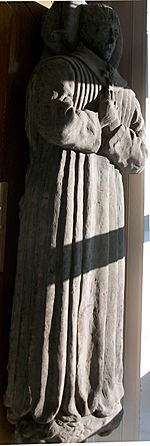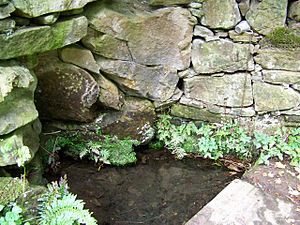Saint Fergus facts for kids
Quick facts for kids Fergus |
|
|---|---|

An effigy of Saint Fergus, carved in the 15th Century.
|
|
| Bishop | |
| Born | unknown Ireland |
| Died | c. 730 Scotland |
| Venerated in | Catholic Church Eastern Orthodox Church Anglican Communion |
| Feast | 8 September (Ireland) 18 November (Scotland) |
Saint Fergus (also known as Fergustian) was an important bishop and missionary. He lived around 730 AD and traveled across Scotland. He helped spread the Christian faith.
Who Was Saint Fergus?
No one knows exactly when or where Fergus was born. He lived around the same time as other saints, like Drostan and Donevaldus. His name, Fergus, comes from the ancient Pictish people. He was known as a Pictish bishop. This suggests he likely came from what is now northeast Scotland.
Old records, like the Aberdeen Breviary, call him Fergustian. They say he worked hard to teach people about Christianity. It is thought he trained in Ireland or southern Scotland. He might have even trained in both places.
Fergus's Journeys and Churches
In Irish records, he is called St. Fergus Cruithneach, or "the Pict." The Breviary of Aberdeen says he was a bishop in Ireland for many years. Then, he went on a mission to Alba (an old name for Scotland). He brought along some priests and other helpers.
He first settled near Strageath, in Upper Strathearn. This area is in Upper Perth. There, he built three churches. The churches of Strageath, Blackford, and Dolpatrick are still found there. They are dedicated to Saint Patrick.
Next, he traveled to Caithness in northern Scotland. He helped spread Christianity there. He also built churches in the towns of Wick and Halkirk.
The church Fergus built at Glamis would have been simple. It was likely made of mud and branches, a style common for Celtic churches. This church was not far from the present-day kirk (church). Some people think he might be the Fergustus Pictus who visited Rome in 721. However, this is just a guess based on his common name.
Saint Fergus died around 730 AD. He was buried at Glamis, in Angus. You can still visit the recently restored St Fergus' Well there. The village church at Eassie is also dedicated to Saint Fergus. The famous Pictish Eassie Stone is now kept inside that church.
Honoring Saint Fergus
Over time, people continued to honor Saint Fergus. During the rule of King James IV, the Abbot of Scone moved Fergus's head. It was taken to Scone church. A very expensive shrine was built for it there. The city of Aberdeen was able to get one of the saint's arms.
Saint Fergus is considered the patron saint of Glamis and Wick. This means he is a special protector of these places.
His feast day is mentioned on September 8th in the Martyrology of Tallaght. However, in Scotland, it was previously celebrated on November 18th.
See also


